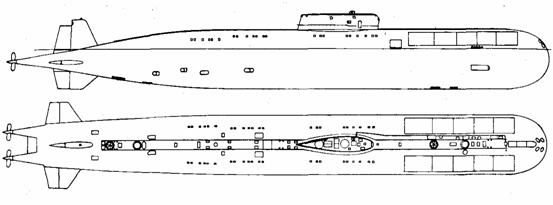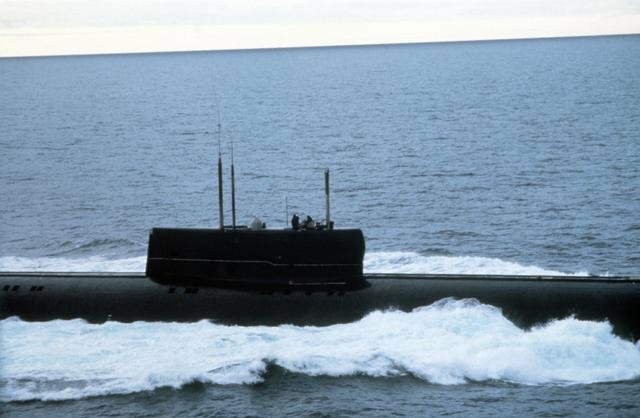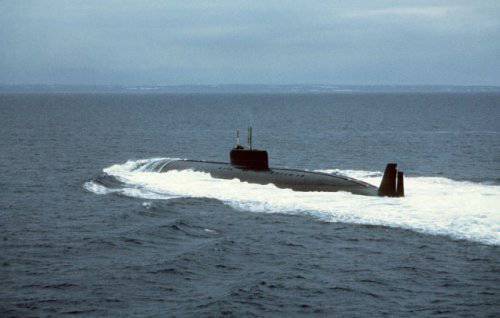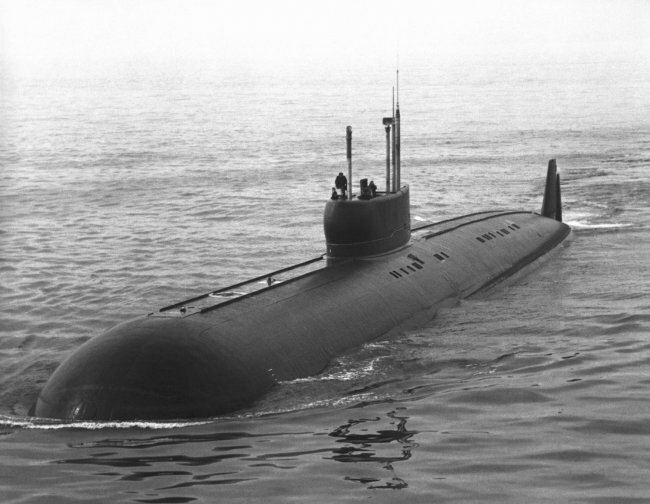Goldfish
The K-162 submarine (“Anchar”, in the classification of NATO - PAPA) was laid 28 December 1963 in Severodvinsk and commissioned 31 December 1969. The boat received its second name “Golden Fish” because of the high cost opportunities. The submarine was set to speed in the 44,7 node (more than 80 km / h), which to date has been an absolute world record for submarines.
28 August 1958 was adopted by the party and government decree "On the creation of a new high-speed submarine with new types of power plants and the development of research, development and design work for submarines." The priority tasks were to increase the speed of the underwater stroke and the depth of the dive compared to the submarines of the 1-th generation in a half to two times. It was planned to create a power plant of reduced dimensions with a decrease in the total specific weight of reactors and turbines in 1,5 - 2 times, a new small-sized missile anti-ship complex with an underwater launch, distance-based high-speed two-plane torpedoes that can be used at dive depths that are twice as large as at boats of existing projects. It was supposed to introduce new structural materials, allowing, in combination with the adoption of other measures, to reduce the displacement and size of submarines. All this was to ensure the qualitative superiority of Soviet submarines over promising American submarines. As part of this decree, TsKB-16 of the State Shipbuilding Committee (now SPMBM Malakhit) began the development of an experimental high-speed nuclear submarine of the 661 project (code “Anchar”). Works on this topic were considered by the leadership of the shipbuilding industry as the highest priority. A very unusual requirement was put forward before the creators of the ship - to abandon the use of previously mastered technical solutions, materials and equipment. Everything is just new, the most promising! The Central Research Institute No. 661 (now the Central Research Institute named after Academician A.N. Krylov) took an active part in the work on the 45 project. The institute investigated both the ship’s own issues related to the creation of a new nuclear-powered ship and the combat effectiveness of a high-speed submarine. Considered three alternative basic structural materials for the manufacture of durable housing - steel, aluminum or titanium. In the end, it was decided to choose a titanium. This made it possible to drastically reduce the mass of the hull (and, consequently, the displacement of the ship). Thus, one of the most important unmasking signs of the boat, its magnetic field, was significantly reduced. As a result, in 1959, the government issued a decree on the creation of titanium alloys for the manufacture of sheet metal, stampings, forgings, pipes, etc.
After considering two types of reactors - a simpler and more advanced water-to-water and promising liquid metal (primary coolant - lead and bismuth alloy) - the first was chosen as the most realistic in terms of creation, although it has the worst specific parameters.
14 basic and six additional versions of the pre-sketch project were worked out. Considered alternative submarine armament: cruise missiles with the submarine launch “Amethyst”, created under the guidance of General Designer V.N.Chelomey, KR with surface launch (Chief Designer G.M. Beriev) or new torpedoes of increased power that were at that time under development. The choice of the main armament required a comparative assessment of the effectiveness of submarine variants. As a result of research conducted by CRI-45, preference was given to the version with the Amethyst missiles. A government decree on the development of the world's first cruise missile with an underwater launch was issued on 1 on April 1959, and on 9 on April of the same year, the sub-draft design of the submarine was approved. The development of the technical design of SSGNs of the 661-th project was completed in December. 1960. Powerful nuclear power engineering combined with new hull lines provided the submarine with unique speed characteristics. In accordance with the project, the ship was to develop a maximum underwater speed of at least 37 - 38 nodes, which exceeded the speed of any warship of the US Navy. Designing the SSGN was conducted under the direction of the chief designer N.N.Isanin (later he was replaced by N.F. Shulzhenko). The main observers from the Navy were Yu. G. Ilyinsky, and then - V. N. Markov. A total of more than 400 organizations and enterprises were involved in the work on the program.
An experienced submarine was designed to assess the basic tactical and technical characteristics, to test in practice the effectiveness of new types of weapons and technical equipment, as well as to master the construction of a submarine hull made of titanium alloy. The combat mission of the ship was the fight against aircraft carriers and high-speed escort ships. During the design and construction of the boat, the technology of welding of hull structures made of high-strength titanium alloys, the manufacture of castings, forgings, reinforcement and other products were tested. To work with titanium at the Northern machine-building enterprise, it was necessary to create special workshops and other premises. For carrying out static and dynamic tests, the semi-gage compartments SMT60-1 and DMT60-2 were manufactured (the first was tested in the dock chamber, and the second - at the sea testing range).

In 1962, at the Northern Machine-Building Enterprise, the manufacture of the first frames and shells of the durable hull of the 661-th project began. However, the first tests of elements of hull structures made of titanium alloy failed, and additional work was required. As a result, the official laying of the submarine 661-th project was carried out in Severodvinsk only 28 December 1963.
The high degree of novelty and complexity of the project led to a long period of its implementation. Work on the creation of the ship lasted a total of over 11 years. The delay in construction was also affected by the low rates of supply of titanium in short supply at that time, which was also badly needed by aircraft manufacturing and rocket production. As a result, the submarine, which received the tactical number K-162, was launched only 21 in December 1968, 13 in December 1969, she entered the factory running tests. During testing at 92% power plant at a relatively shallow water range (water depth - 200 m, running depth - 100 m), the maximum underwater speed equal to 42 nodes was obtained, which significantly exceeded the design parameters (38 nodes). Thus, the world speed record for submarines, previously held by the ships of the 671 project (33,5 node), was set. The fastest American ALL developed only 30 nodes. Later, when the power plant reached full capacity and at a deep-water polygon, even better results were obtained - the 44,7 node (when forcing the power plant it was possible to briefly exceed the 45 nodes). It is still the absolute world speed record for submarines.
The SSGN of the 661 project had a two-shell architecture. Durable case, made of titanium alloy, was divided into nine compartments:
- 1-th (upper) and 2-th (lower) compartments having the shape of a figure of eight, formed by two intersecting circles with a diameter of 5,9 m each (torpedo tubes with spare ammunition and a fast-loading device were placed in them);
- 3-th - living quarters, nutrition unit, saloon, batteries;
- 4-th - CPU, power management post, residential unit;
- 5 - reactor;
- 6-th - turbine;
- 7 - turbogenerator;
- 8-th - auxiliary machinery compartment (refrigerators, compressor machines, water desalination plant);
- 9 st - steering gear and bilge post.
The stern end of the boat was made bifurcated in the form of two axially symmetric conical shaft fairings with a distance between them of the order of 5 m (in everyday use this decision was called “pants”). Hydrodynamic optimization of the shape of the aft tip was achieved due to its elongation with small angles of the waterline in the diametral plane and the use of elongated propeller shafts with fairings that allow installation of propellers of the optimum diameter for a given rotation frequency.
Power plant power 80 000 l. with. included two autonomous groups (right and left sides). Each group combined the B-5P nuclear power plant, the GTZA-618 turbo-gear unit, and the OK-3 turbo-generator of alternating three-phase current with 2x3000 kW. The nominal thermal power of two atomic water-to-water type reactors was 2х177,4 mW, and the steam generating capacity of the PUF at normal reactor power was 2x250 tons of steam per hour.
The reactors developed for the boat of the 661 project had a number of original features. In particular, the pumping of the primary coolant was carried out according to the “pipe in pipe” scheme, which ensured the compactness of nuclear power plants under high thermal stress. In this case, the reactors operated not only on thermal neutrons, but also with the participation of the fission of the nuclear "fuel" of fast neutrons. To supply the main consumers of electrical energy, an alternating three-phase current of voltage 380 V and frequency 50 Hz was adopted. A significant innovation was the rejection of the use of diesel generators: as an emergency source, a powerful rechargeable battery was used, consisting of two groups of silver-zinc batteries of the 424-III type along the 152 element each. On board the ship there was the Sigma-661, an all-wide navigation complex, providing underwater and under-ice navigation.
The automatic control of the ship was carried out through the control system at the course and depth of the Spar, the emergency trimming and failure prevention system Tourmaline, as well as the control system for the general ship systems, devices and outboard openings Signal-661.
The MHC-300 “Rubin” hydroacoustic complex provided detection of noisy targets with simultaneous automatic tracking of two of them with delivery of data to the missile and torpedo control systems. weapons. The circular detection of the enemy GAS signals operating in the active mode, as well as their identification with the determination of bearing and distance, were provided. To detect anchor mines, the ship had GAS "Radian-1". To monitor the air and surface situation, the submarine was equipped with the PNZN-9 anti-aircraft aperture periscope with an optical coordinate transmitter. The lifting device made it possible to lift the periscope from depth to 30 m at speeds up to 10 nodes and waves to 5 points. There were RAK-101 and MTP-10 radars, as well as the Nichrom state identification system. For two-way ultra-high-speed classified radio communications with coastal command posts, other ships and aircraft interacting with a submarine, there was a modern (by the standards of 1960-s) radio communication equipment. The ship was equipped with a radio intelligence system, which provides for the search, detection and direction finding of operating enemy radio stations. The main armament was presented by the Amethyst anti-ship missile system with 10 cruise missiles deployed in inclined containers positioned outside the robust hull. The maximum firing range was 70 km. The launch of the rocket was carried out from a submerged position from a depth of 30 m from a container previously submerged by the intake water. Immediately after exiting the container, the starting engine worked and the wing opened, and in the surface position the sustained solid-fuel engine was activated. The rocket complex also included equipment for pre-launch control, instruments for the onboard control system for rocket shooting, related to the hydroacoustic complex, the control complex for torpedo shooting, the navigation complex, as well as the course and depth control stabilizer. The launcher provided storage, transportation, remote pre-launch preparation and launch of cruise missiles without access to the container. KR were taken aboard the ship in a state fully equipped for launch. They were securely stored and launched during a three-month stay at sea. The entire rocket ammunition could have been fired in two volleys, the interval between which was three minutes (according to experts, this was a major tactical drawback of the project, which hampered the effective use of the SSGN in the main objectives - aircraft carriers). In the fore end of the submarine there were four 533-millimeter torpedo tubes (the total ammunition load - 12 torpedoes), which ensured bubble-free shooting from depth to 200 m. Torpedo shooting was controlled by the automated system Ladoga-P-661. On tests, K-162 demonstrated high maneuverability in both vertical and horizontal planes. Possessing unique speed and maneuvering characteristics, combined with a powerful sonar complex with a long detection range, the SSGN of the 661 project could quickly deploy in a given area of combat operations, as well as select a vantage point for using weapons and making repeated attacks, which greatly expanded it combat capabilities compared with nuclear projects of other projects. The boat was a kind of laboratory, where in natural conditions the development of new types of weapons and weapons was carried out. Much of what was created for this experienced submarine was later used on new ships of other projects. Trial operation of the ship began in 1970. and ended in December 1971. In September, the 1971 K-162 entered the first combat service, during which the ship passed from the Greenland Sea to the Brazil Basin, to the equator, performing a number of tasks together with other submarines and surface ships. The aircraft carrier Saratoga was escorted. At the same time, the American ship repeatedly tried to break away from the submarine, developing a speed of more than 30 nodes, however, it failed to achieve the desired result. Moreover, the submarine, carrying out maneuvers, sometimes ahead of the American ship.

After the trial operation, K-162 was repaired in Severodvinsk and in 1974 returned to combat fleet.
In the West, the 661 project boat was named Papa (“Papa”). In our fleet, it was called the “Golden Fish” (some time ago this very prestigious nickname wore the ALL of the 645 project).
Initially, it was assumed that after the head (experimental) submarine of the 661 project was built, another tab of 10 serial ships of this type would follow. However, in the future, the number of serial SSGNs was reduced to five, then to three, and in the new five-year plan adopted in 1964 they decided to limit themselves to the construction of one nuclear-powered 661 project. This was largely due to the lack of titanium in the country, as well as technological difficulties that significantly delay the construction of such a unique ship. In 1970, the question of laying a series of SSGNs of an advanced project, 661M, was again discussed. Three variants of the submarine, differing in displacement (from 5197 to 6208 t), underwater speed (39 - 42 node), GEM (43 000 - 55 000 hp) and other parameters were worked out. However, by this time serial construction was already deployed which did not possess such high speed characteristics, but much cheaper and low-noise submarines of the 670 project, having comparable strike power. In addition, significant changes were required to the missile firing system of the SSGN 661 project: to fire all 10 cruise missiles in one salvo, it was necessary to radically alter the submarine's possession system at the starting depth, and this entailed major changes in the design and , as a result, caused the increase in displacement.
Not satisfied with the fleet and the high underwater noise of the ship. The increased level of intrinsic acoustic noise hampered the operation of the hydroacoustic complex. Under these conditions, it was decided to abandon the serial construction of nuclear submarines based on the 661 project. Proposals for upgrading the K-162, including the installation of the P-120 rocket complex with subsequent replacement with the Granat complex, have not received development. K-162 was in the ranks of the Northern Fleet until 1988, after which it was withdrawn to the reserve, and later transferred to recycling.
25.07.2008 11:00
The 23 of July at Sevmash was used for the disposal of a nuclear submarine of the K-162 project, reports the news agency Rosbalt-North.
Specialists from the Zvezdochka shipyard will deal with the dismantling of the boat, which came down from the Sevmash stocks in due time. As the General Director of Sevmash Nikolay Kalistratov noted, the record of the Golden Fish boat has not yet been beaten, including by the Americans who tried to create such projects.
The submarine K-162 (“Anchar”, in the classification of NATO - PAPA) was laid 28 December 1963 in Severodvinsk and commissioned 31 December 1969. The boat received its second name “Golden Fish” for its hull was made from a unique titanium alloy that had a golden hue. The submarine was set to speed in the 44,7 node (more than 80 km / h), which to date has been an absolute world record for submarines.
In March, the 1989 of the Golden Fish was taken out of service of the Navy and since then has been standing idle at the berth of the NSR with a non-loaded active zone.


Information